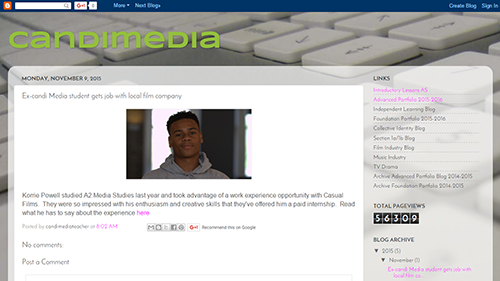Turning Media students into critical consumers - Rebecca Morris
03 December 2015
I’m going to nail my colours to the mast: I think everyone should study Media Studies, or at the very least have an awareness of how the media works. I think everyone should understand the process of construction and manipulation involved in the creation of media texts.
An activity we do with our new AS students at the start of the academic year asks them to sort a range of media texts into the categories ‘reality’ or ‘constructed’. Students look through laminated images from soaps, reality TV programmes, music videos, tweets, Instagram accounts, newspaper articles and discuss how the media form may influence the category. Much debate ensues. They are confident about Eastenders and Hollyoaks being in the ‘constructed’ pile and feel strongly that Keeping up with the Kardashians, a tweet from Harry Styles and an article from The Mirror must be in the ‘not constructed’ pile because it’s ‘true’.
It’s at this point the discussion gets interesting. The students are unaware (and you could argue that this is to be expected given that they’ve not started the course yet!) of how what they immerse themselves in is constructed for an audience and to generate a reaction or manipulate an audience. They struggle to understand that a newspaper article and accompanying image of an event are in any way ‘constructed’ for an audience, and have gone through the process of mediation.
This year we were given the gift of a poor Guardian review of the film Legend and used this as a way in to discussing how images are frequently manipulated for effect. The two-star review that the film received from Benjamin Lee was hidden behind the heads of the two Tom Hardies to make it look like a much better review. Our students were outraged that this was ‘allowed to happen’.
We also looked at an iconic image taken during the riots in London in 2011 which shows a young man walking in front of a burning car. The way this shot is cropped suggests that he’s responsible for the fire, however the original image tells a very different story. Again, our students question how this can be. They spent time thinking about who gets left out of images that are cropped and why this is. It’s a really exciting conversation to have with a new Media Studies student and we actively encourage our students to question what they see and read all the time.
The activity continues during our induction period. We explore how the construction process happens, why it happens, how methods of distribution and audience affect the construction process and what the possible motives behind this may be. It’s a real pleasure to see so many eager students questioning what they are engaging with. The challenge then, for the Media Studies teacher, is to maintain this enthusiasm as the year progresses!
About the author
Rebecca Morris - Head of Subject, Media Studies, at City and Islington Sixth Form College
 Rebecca Morris has taught at City and Islington Sixth Form College since September 2002. She has been head of subject for Media Studies since 2005 and manages ‘a brilliant group of students and staff’ that make up a cohort of around 260 AS and A2 Media Studies students.
Rebecca Morris has taught at City and Islington Sixth Form College since September 2002. She has been head of subject for Media Studies since 2005 and manages ‘a brilliant group of students and staff’ that make up a cohort of around 260 AS and A2 Media Studies students.
Besides teaching, Rebecca has been involved in a range of work for OCR. Outside of work, Rebecca says looking after her retired greyhound keeps her sane and reminds her that there is life beyond the classroom, although she does still really enjoy teaching.
You can read more about Rebecca and her students' work on their blog: http://candimedia6.blogspot.co.uk/
